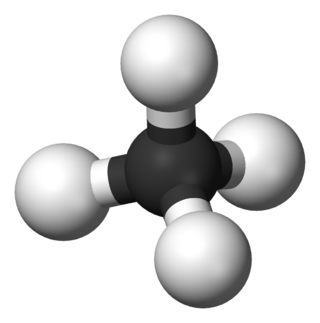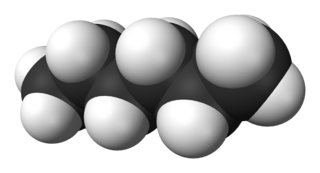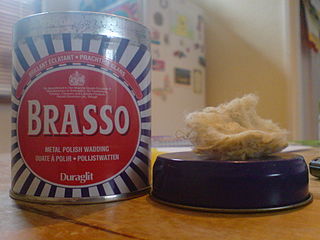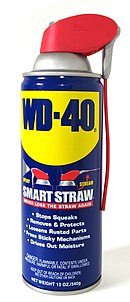
In organic chemistry, an alkane, or paraffin, is an acyclic saturated hydrocarbon. In other words, an alkane consists of hydrogen and carbon atoms arranged in a tree structure in which all the carbon–carbon bonds are single. Alkanes have the general chemical formula CnH2n+2. The alkanes range in complexity from the simplest case of methane, where n = 1, to arbitrarily large and complex molecules, like pentacontane or 6-ethyl-2-methyl-5-(1-methylethyl) octane, an isomer of tetradecane.

In organic chemistry, a hydrocarbon is an organic compound consisting entirely of hydrogen and carbon. Hydrocarbons are examples of group 14 hydrides. Hydrocarbons are generally colourless and hydrophobic; their odor is usually faint, and may be similar to that of gasoline or lighter fluid. They occur in a diverse range of molecular structures and phases: they can be gases, liquids, low melting solids or polymers.
Kerosene, or paraffin, is a combustible hydrocarbon liquid which is derived from petroleum. It is widely used as a fuel in aviation as well as households. Its name derives from Greek: κηρός (kērós) meaning "wax", and was registered as a trademark by Nova Scotia geologist and inventor Abraham Gesner in 1854 before evolving into a generic trademark. It is sometimes spelled kerosine in scientific and industrial usage.

Waxes are a diverse class of organic compounds that are lipophilic, malleable solids near ambient temperatures. They include higher alkanes and lipids, typically with melting points above about 40 °C (104 °F), melting to give low viscosity liquids. Waxes are insoluble in water but soluble in nonpolar organic solvents such as hexane, benzene and chloroform. Natural waxes of different types are produced by plants and animals and occur in petroleum.

Hexane or n-hexane is an organic compound, a straight-chain alkane with six carbon atoms and the molecular formula C6H14.
Decane is an alkane hydrocarbon with the chemical formula C10H22. Although 75 structural isomers are possible for decane, the term usually refers to the normal-decane ("n-decane"), with the formula CH3(CH2)8CH3. All isomers, however, exhibit similar properties and little attention is paid to the composition. These isomers are flammable liquids. Decane is present in small quantities (less than 1%) in gasoline (petrol) and kerosene. Like other alkanes, it is a nonpolar solvent, and does not dissolve in water, and is readily combustible. Although it is a component of fuels, it is of little importance as a chemical feedstock, unlike a handful of other alkanes.
Starting fluid is a volatile, flammable liquid which is used to aid the starting of internal combustion engines, especially during cold weather or in engines that are difficult to start using conventional starting procedures. It is typically available in an aerosol spray can, and may sometimes be used for starting direct injected diesel engines or lean burn spark engines running on alcohol fuel. Some modern starting fluid products contain mostly volatile hydrocarbons such as heptane, with a small portion of diethyl ether, and carbon dioxide. Some formulations contain butane or propane as both propellant and starting fuel. Historically, diethyl ether, with a small amount of oil, a trace amount of a stabilizer and a hydrocarbon propellant has been used to help start internal combustion engines because of its low 160 °C (320 °F) autoignition temperature.

Pentane is an organic compound with the formula C5H12—that is, an alkane with five carbon atoms. The term may refer to any of three structural isomers, or to a mixture of them: in the IUPAC nomenclature, however, pentane means exclusively the n-pentane isomer, in which case pentanes refers to a mixture of them; the other two are called isopentane (methylbutane) and neopentane (dimethylpropane). Cyclopentane is not an isomer of pentane because it has only 10 hydrogen atoms where pentane has 12.

Brasso is a metal polish designed to remove tarnish from brass, copper, chrome and stainless steel. It is available either directly as a liquid or as an impregnated wadding pad.

Nonane is a linear alkane hydrocarbon with the chemical formula C9H20. It is a colorless, flammable liquid, occurring primarily in the component of the petroleum distillate fraction commonly called kerosene, which is used as a heating, tractor, and jet fuel. Nonane is also used as a solvent, distillation chaser, fuel additive, and a component in biodegradable detergents.
The Fischer–Tropsch process (FT) is a collection of chemical reactions that converts a mixture of carbon monoxide and hydrogen, known as syngas, into liquid hydrocarbons. These reactions occur in the presence of metal catalysts, typically at temperatures of 150–300 °C (302–572 °F) and pressures of one to several tens of atmospheres. The Fischer–Tropsch process is an important reaction in both coal liquefaction and gas to liquids technology for producing liquid hydrocarbons.
Petroleum geochemistry is a branch of geochemistry which deals specifically with petroleum and its origin, generation, and accumulation, as well as its extraction, refinement, and use. Petroleum, also known as crude oil, is a solid, liquid, and/or gaesous mix of hydrocarbons. These hydrocarbons are from the burial and metamorphosis of organic matter from millions of years ago; the organic matter is from marine animals, plants, and algae. Petroleum is extracted from the Earth, refined, and used as an energy source.
Norman Bernard Larsen (1923—1970) was an American industrial chemist.

Fluid catalytic cracking (FCC) is the conversion process used in petroleum refineries to convert the high-boiling point, high-molecular weight hydrocarbon fractions of petroleum into gasoline, alkene gases, and other petroleum products. The cracking of petroleum hydrocarbons was originally done by thermal cracking, now virtually replaced by catalytic cracking, which yields greater volumes of high octane rating gasoline; and produces by-product gases, with more carbon-carbon double bonds, that are of greater economic value than the gases produced by thermal cracking.

Hydrodesulfurization (HDS), also called hydrotreatment or hydrotreating, is a catalytic chemical process widely used to remove sulfur (S) from natural gas and from refined petroleum products, such as gasoline or petrol, jet fuel, kerosene, diesel fuel, and fuel oils. The purpose of removing the sulfur, and creating products such as ultra-low-sulfur diesel, is to reduce the sulfur dioxide emissions that result from using those fuels in automotive vehicles, aircraft, railroad locomotives, ships, gas or oil burning power plants, residential and industrial furnaces, and other forms of fuel combustion.
John Steven Barry was an American business executive who popularized WD-40, a water-displacing spray and solvent that had been created in the 1950s for use in the space program and spread its use in the consumer market.

Joule Unlimited, formerly known as Joule Biotechnologies, was a producer of alternative energy technologies based in Bedford, Massachusetts. The company developed a process to generate hydrocarbon-based fuel by combining non-fresh water, nutrients, cyanobacteria, carbon dioxide, and sunlight. After ten years of operation and building a demonstration plant in New Mexico, the company shut down in August 2017. The company shut down after management was unable to raise money.

CRC Industries is a manufacturer and distributor of industrial chemicals for maintenance and repair of marine, electrical, industrial, automotive and aviation equipment.

The WD-40 Company, originally the Rocket Chemical Company, is an American manufacturer of household and multi-use products, including its signature brand, WD-40, as well as 3-In-One Oil, Lava, Spot Shot, X-14, Carpet Fresh, GT85, 1001, Solvol, 2000 Flushes and No Vac. It is based in San Diego, California.

Iris Higbie Wilson Engstrand is a retired American academic. She was professor of history at University of San Diego from 1968 until 2017; she joined the faculty of the San Diego College for Men before it and other colleges joined to form the university in 1972.















